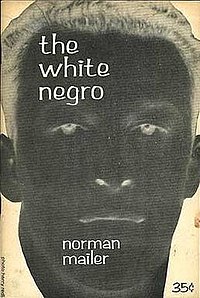The White Negro
by Norman Mailer
The White Negro is a 9,000-word essay divided into six sections of varying lengths.
In 'Section 1', Mailer argues that the twin horrors of the atom bomb and the concentration camps have wrought "psychic havoc" by subjecting individual human lives to the calculus of the state machine. The collective practices of Western progress seem to render life and death meaningless for the individual who is compelled to join the numbed masses in a "collective failure of nerve".
{{Quote box
| quote = The hipster had absorbed the existentialist synapses of the Negro, and for practical purposes could be considered a white Negro.
{{Quote box | quote = For Hip is the sophistication of the wise primitive in a giant jungle, and so its appeal is still beyond the civilized man. | source = —§3, p. 343 | align=right |width=30em |salign=right }} 'Section 3' defines the Hipster further as a "philosophical psychopath" interested in codifying, like Hemingway, Section 3 ends with an introduction to the language of Hip, a "special language" that "cannot be taught" because it is based on a shared experience of "elation and exhaustion" and the dynamic movements of man as a "vector in a network of forces" rather than "as a static character in a crystalized field". 'Section 4' develops this language further, linking the language to movement and the search for the "unachievable whisper of mystery within the sex, the paradise of limitless energy and perception just beyond the next wave of the next orgasm." {{Quote box | quote = Truth is no more nor less than what one feels at each instant in the perpetual climax of the present. | source = —§5, p. 354 | align=right |width=30em |salign=right }} 'Section 5' posits that the Hip judgement of character is "perpetually ambivalent and dynamic".
Finally, in 'Section 6', Mailer speculates whether "the last war of them all" will be between factions of socially polar communities or through despair at the current crisis of capitalism. Perhaps, Mailer ends, we still have something to learn from Marx.
